
* Two of the most prominent jet transport aircraft in US military service are the Lockheed "C-141 Starlifter" and its "big brother", the huge "C-5 Galaxy". This document provides a history and description of these two aircraft.
* In the 1950s, the US Air Force's Military Air Transport Service (MATS) was reliant on piston-engined cargolifters, such as the Douglas C-124 Globemaster. By the end of the decade, MATS brass had decided that they needed a more capable cargolifter, and in the spring of 1960 the USAF issued a request for proposals under the designation "Specific Operational Requirement 182 (SOR 182)". SOR 182 specified an aircraft with a cargo capacity of 27,200 kilograms (60,000 pounds) and a range of 6,480 kilometers (4,025 miles). Lockheed's proposal was selected, with an initial contract for five "development, test, and evaluation (DT&E)" aircraft awarded on 13 March 1961. The aircraft was given the designation "C-141 Starlifter".
The Starlifter incorporated ideas from Lockheed's earlier C-130 Hercules cargolifter, including a high wing; a loading ramp under the high tail; clamshell rear doors that could be opened in flight for airdrops; and main landing gear that retracted into fairings alongside the fuselage to ensure an unobstructed cargo hold. The Starlifter differed from the Hercules in having wings with a sweepback of 25 degrees and a tee tail, instead of straight wings and a conventional tail; and four Pratt & Whitney TF33-P-7 turbofans with 43.2 kN (9,525 kgp / 21,000 lbf) thrust, each mounted in pods on underwing pylons, instead of turboprops mounted on the wing. There were typically five flight crew.
Initial flight of the Starlifter was on 17 December 1963. The first production "C-141A" was delivered to the USAF Military Airlift Command (MAC, successor to MATS) on 23 April 1965. A total of 284 C-141As was built through February 1968.
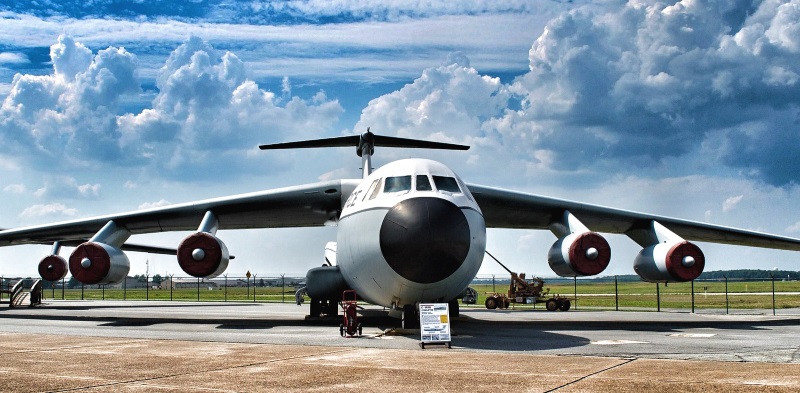
Once in service, the Starlifter immediately began daily shuttle flights from the continental US to Vietnam, carrying 138 passengers in rearward-facing seats -- a configuration the Air Force decided provided better safety in crashes; or up to ten standard 463L pallets with a total of 28,880 kilograms (62,700 pounds) of cargo. It returned with casualties: the aircraft could carry 80 litters with 23 medical attendants. A few Starlifters were modified to carry Minuteman ICBMs from the factory to operational bases.
BACK_TO_TOP* In practice, MAC found that the Starlifter's cargo hold volume was too small relative to its weight-lifting capability, meaning the aircraft often ran out of space well before it met its weight limit. To resolve this problem, in 1976 the USAF began a program to "stretch" the Starlifter with fuselage "plugs" in front of and behind the wing, increasing the length of the aircraft by 7.11 meters (23 feet 4 inches) and providing space for three more standard pallets, for a total of 13. The upgrade also involved the addition of a boom-refueling receptacle behind the cockpit.
The first "YC-141B" conversion performed its initial flight on 24 March 1977. A total of 270 "C-141B" conversions was performed through June 1982. The Air Force was very pleased with the conversion program, since it came through ahead of schedule and under budget, and gave MAC an increased airlift capacity equivalent to 90 more C-141As.
___________________________________________________________________
LOCKHEED C-141B STARLIFTER:
___________________________________________________________________
wingspan:
48.74 meters (159 feet 11 inches)
wing area:
300 sq_meters (3,228 sq_feet)
length:
51.29 meters (168 feet 4 inches)
height:
11.96 meters (39 feet 3 inches)
empty weight:
677,200 kilograms (148,120 pounds)
loaded weight:
155,600 kilograms (343,000 pounds)
max cruise speed:
910 KPH (565 MPH / 490 KT)
normal cruise speed:
800 KPH (495 MPH / 430 KT)
service ceiling:
12,500 meters (41,000 feet)
loaded range:
4,725 kilometers (2,935 MI / 2,555 NMI)
___________________________________________________________________
* Four "NC-141As" that were built as testbeds were not converted to C-141B standards. One of these, the "L-300" prototype for a commercial Starlifter that never went into production, was obtained by the US National Aeronautics & Space Administration (NASA) as a flying astronomical observatory and designated the "Kuiper Airborne Observatory (KAO)".
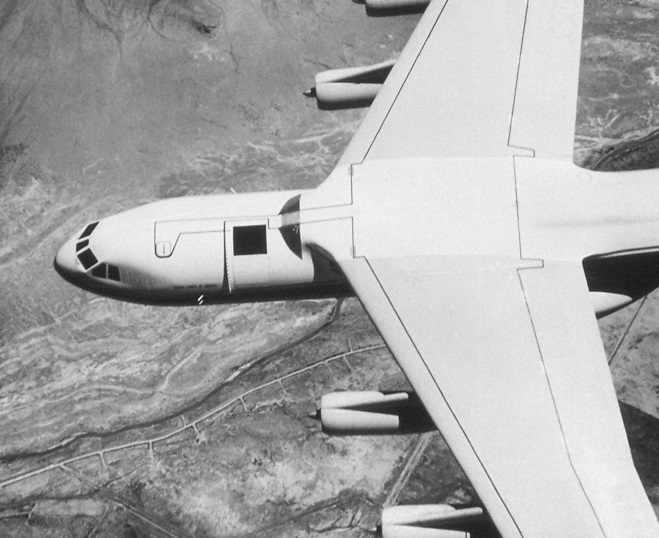
KAO was primarily intended to perform infrared observations of cosmic objects with a 91-centimeter (36-inch) telescope, mounted to perform observations out a hole in the fuselage. Such observations must be performed at high altitude, since the atmosphere absorbs infrared radiation. KAO went into service in 1974, and obtained many significant astronomical observations. The flying observatory was retired in 1995, as NASA was beginning work on a much more sophisticated flying observatory based on the Boeing 747SP jumbo jetliner, designated the "Stratospheric Observatory for Infrared Astronomy (SOFIA)". Retiring KAO freed up funds for the SOFIA effort.
* In 1994, the Air Force began a program to refit 13 C-141Bs to the "Special Operations Low-Level II (SOLL II)" standard, with a total program cost of $41 million USD. These aircraft were operated by the USAF in behalf of the US Special Operations Command, and included gear for low-level night flying, as well as defensive countermeasures.
The SOLL designation was a bit confusing; it only defined an operational mode, SOLL I being daylight low-level operations, and SOLL II being night low-level operations. In other words, SOLL II only described the aircraft mission, and did not imply "the second machine in the SOLL series of platforms". The SOLL II Starlifters were also sometimes referred to as "Special Operations Forces Improvement Modification (SOFI-Mod)" Starlifters.
The SOLL II Starlifter looked much like any other C-141B, but it could be recognized by three "knobs" on its chin. One knob was directly under the nose and was a turret for a Texas Instruments AN/AAQ-17 forward-looking infra-red (FLIR) imager, which gave the aircraft the ability to "see in the dark". The FLIR imagery was displayed on a CRT at the navigator's station, and on an auxiliary display for the pilot. The navigator pointed the FLIR turret using a joystick. The FLIR turret could be removed for maintenance.
The other two knobs were for AN/ALE-40 chaff-flare dispensers, and were mounted on the "cheeks" of the aircraft. There were also chaff-flare dispensers in the landing-gear wheel wells and on the wingtips. In addition, the defensive countermeasures suite included an AN/AAR-44 infrared missile warning sensor fitted under the fuselage, and an AN/ALR-69 radar warning receiver with unobtrusive antennas tacked on to the nose and tail.
The defensive countermeasures system could be set to an "automatic" mode to dispense chaff and flares without crew intervention. The amount of chaff and flares to be dispensed could be preprogrammed. The sensors also provided an audible warning to the crew through their headphones, with the crew dispensing chaff and flares themselves when the system was in "manual" mode. Even the loadmaster could activate the dispensers, as he or she often kept a "SAM (surface-to-air missile) watch" from the rear ramp.
The SOLL II Starlifter also included an enhanced suite of communications equipment and Global Positioning System (GPS) navigation gear. The enhancements of the SOLL II increased its weight by about 680 kilograms (1,500 pounds) compared to a "stock" C-141B. Crews were handpicked for night operations, which were conducted with night vision goggles (NVG). All SOLL II Starlifter cockpit and exterior lighting was NVG-compatible. Additional crewmembers were included for missions of long duration or with high workload requirements. Passengers on SOLL II flights tended to find the low-level flight of the aircraft in pitch darkness, often in formation with another SOLL II aircraft, to be a little unnerving.
* In the post-Vietnam era, the Starlifter was a major player in airlift operations to Haiti, Bosnia, Somalia, and Rwanda. It was used very heavily in the Gulf War in 1991. After the Gulf War, structural problems led to the imposition of flight restrictions, though these problems were quickly resolved by a comprehensive repair program. 63 Starlifters were also upgraded to the "C-141C" standard, with improved avionics, including GPS navigation gear and digital "glass" cockpits.

However, this update was just to provide a little incremental utility to stretch the type's service life a bit. The C-141 performed its final flight for the USAF's Air Mobility Command (AMC), the current incarnation of MATS and MAC, on 16 September 2004, with two aircraft sent off in a special ceremony from McGuire AFB in New Jersey to the "boneyard" at Davis-Monthan AFB in Arizona. Two AF Reserve squadrons continued to operate the type, but phased it out in the summer of 2006. The very last flight of the C-141C was on 6 May 2006, when a machine known as the "Hanoi Taxi" -- for its ferry flights of US prisoners from Hanoi in 1973 -- flew to Wright-Patterson AFB in Ohio for eventual display at the US Air Force Museum. It had performed almost 11,000 landings during its career as a C-141A, B, and C.
BACK_TO_TOP* In 1963, MATS issued a requirement for a "Cargo Experimental Heavy Logistics System (CX-HLS)" that specified a heavy long-range cargolifter to complement the Starlifter. The CX-HLS was to be capable of carrying 56,700 kilograms (125,000 pounds) of cargo over a range of 12,875 kilometers (8,000 miles).
In mid-1964, the USAF issued short-term contracts to Lockheed, Boeing, and McDonnell-Douglas for design studies of the CX-HLS, as well as to General Electric and Pratt & Whitney for design studies of new, highly efficient "high-bypass ratio" turbofans to power the aircraft. GE won the engine competition in August 1963 with what would become the "TF39" turbofan, and Lockheed won the CX-HLS competition in October 1965 with their "L-500" design. The first Lockheed "C-5A Galaxy" flew on 30 June 1968. Deliveries began in 1970. A total of 81 C-5As was built.
The C-5A had the same overall configuration as the C-141, with a high wing featuring a sweep of 25 degrees, four jet engines in pods on underwing pylons, a rear loading ramp, a high tee tail, and main landing gear retracting into fairings. However, it was massively scaled up, with the capability of lifting two main battle tanks or transporting 345 fully-equipped troops. The Galaxy was the largest operational aircraft in the world for 15 years, until it was surpassed by the Soviet Antonov An-124 Condor.
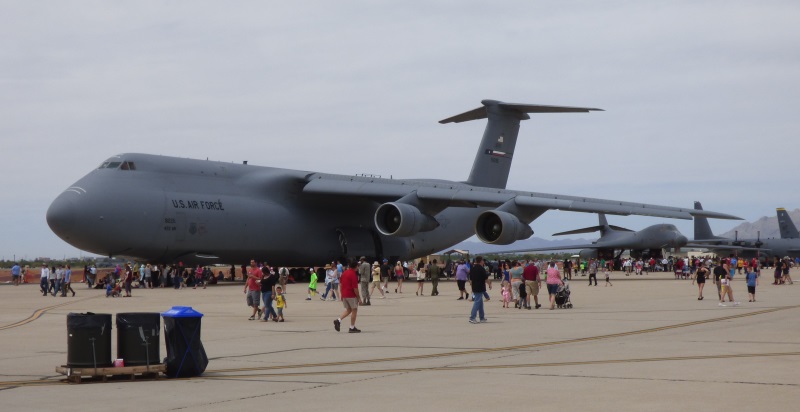
The C-5's nose hinged upward to allow "drive-through" access through the unobstructed cargo bay, which was pressurized and climate-conditioned. The dimensions of the hold were as follows:
meters: 36.91 long (44.09 with ramps) x 4.11 high x 5.79 wide feet: 121 long (144.6 with ramps) x 13.5 high x 19 wide
The upraised nose cleared the cockpit, permitting the aircraft to be taxied with its nose open. The cockpit was placed at the front of an upper flight deck on top of the huge cargo hold, and accommodated a typical flight crew of six. The upper deck also included a 15-person crew-relief compartment with bunks in front of the wing, and a passenger compartment behind the wing with 73 rearward-facing seats.
The C-5A was powered by four General Electric TF39-GE-1 turbofans with 191.3 kN (19,500 kgp / 43,000 lbf) thrust each. All four engines had thrust reversers, and it seems the thrust reversers on the inboard engines could actually be activated while in flight. The aircraft had four sets of main gear, each with two-axle bogies with two wheels in front and four in the rear, and a four-wheel nose gear assembly. The landing gear could "kneel" to assist in loading cargoes, and featured a system to help land in crosswinds. The C-5A had a boom refueling capability from the start, as well as a computerized "Malfunction Detection, Analysis & Recording (MADAR)" diagnostic system that monitored 800 test points in flight or for ground servicing.
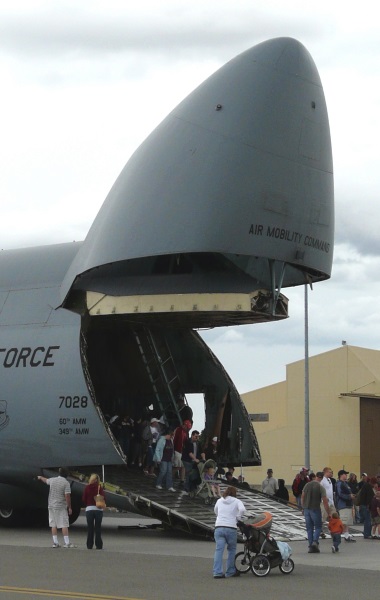
The C-5A proved its worth in the fall of 1973, in Operation NICKEL GRASS, the huge airlift to support Israel during the Yom Kippur war, with the big cargolifter carrying massive quantities of ammunition and weapons to assist Israeli forces. The Galaxy also performed reliable service in the last years of the Vietnam War -- though one was lost on 4 April 1975 while trying to evacuate orphans from Saigon. 206 of the 382 people aboard were killed, many of them infants.
The C-5A's design specifications had been very aggressive and hard to meet. The program did not go smoothly, and in fact the program is said to have coined the term "cost overrun". One of the long-term problems that resulted was that the aircraft did not live up to its fatigue-life specifications, with the wings having barely a quarter of the 30,000-hour lifetime specified. In 1975, Lockheed was awarded a contract to provide new wings to all surviving aircraft to increase the wing service life to the specified 30,000 hours. The first re-winged aircraft was delivered to the USAF in 1983, with the re-winging program complete by July 1987.
* In 1982, the Air Force awarded Lockheed a contract for 50 "C-5Bs" that included the new wing; uprated TF39-GE-1C turbofans; improved alloys and fasteners; and improved avionics, including a MADAR II diagnostic system, Bendix weather radar with a color display, and a Delco triple-redundant inertial navigation system. The crosswind landing system of the C-5A, which had proven unreliable, was eliminated. Initial flight of the prototype was on 30 September 1985. Initial deliveries were in 1986, with all deliveries completed in 1989.
___________________________________________________________________
LOCKHEED C-5B GALAXY:
___________________________________________________________________
wingspan:
67.88 meters (222 feet 9 inches)
wing area:
576 sq_meters (6,200 sq_feet)
length:
75.54 meters (247 feet 10 inches)
height:
19.85 meters (65 feet 2 inches)
empty weight:
169,650 kilograms (374,000 pounds)
loaded weight:
379,700 kilograms (837,000 pounds)
max cruise speed:
910 KPH (565 MPH / 490 KT)
service ceiling:
10,900 meters (35,750 feet)
fully-loaded range:
5,525 kilometers (3,435 MI / 2,990 NMI)
___________________________________________________________________
* Two C-5s were fitted with a countermeasures suite much like that fitted to the SOLL II Starlifters, under a program designated PACER SNOW. Although some sources claim there were considerations for fitting the entire C-5 fleet with PACER SNOW gear, it didn't happen.
Two C-5As were modified for NASA to carry space shuttle payload bay cargoes, and were given the new designation of "C-5C". They were also known as the "Space Container Transport System (SCTS)", "Space Container Modifications (SCM)", "SCM Birds", or "Scum Birds". They were flown by Air Force crews but were under NASA's operational control, and the USAF had to ask NASA for permission to use them for non-NASA-related missions. They were also rumored to be used for ferrying top-secret cargoes to isolated bases for testing, but of course the government had no comment on such matters. With the end of the shuttle program, it appears these two machines were returned to general Air Force service.
* The Galaxy, or "FRED (Fantastic [or something like that] Ridiculous Economic Disaster)" as it is known to its crews, has been a valuable asset for US military overseas deployments for three decades, and served with particular distinction in the Gulf War, lifting in a little more than two weeks more than the entire Berlin Airlift in 1949. One was lost in a crash at Ramstein Air Force Base in Germany on 29 August 1990. The accident was a misfortune, but at least it was the only loss of a transport during the Gulf War airlift, and only the fifth Galaxy lost during its entire operational history.
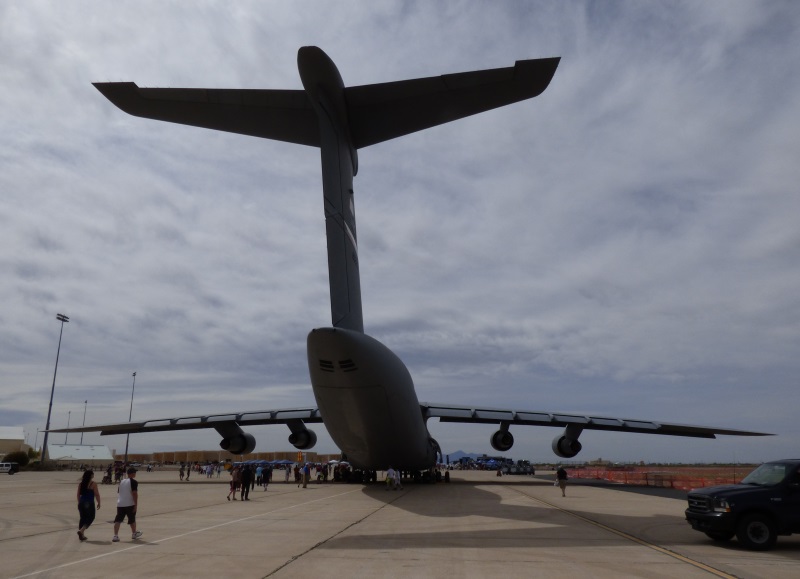
The C-5 has also served in later campaigns, up to and including the US occupation of Iraq. One was hit by what appears to have been a shoulder-fired SAM while leaving Baghdad International Airport on 8 January 2004. The transport's number four engine exploded, but the crew managed to get the machine turned back around and down onto the runway with no casualties.
BACK_TO_TOP* In 2000, the AMC operated 126 C-5s, including 74 C-5As, 50 C-5Bs, and two C-5Cs. The last of the C-5As was retired in 2017, but the surviving fleet represents a major asset that won't go away soon.
The FRED had an excellent safety record, but its mission availability rate left much to be desired. A set of upgrade programs were accordingly put in motion to keep the C-5 flying. The initial phase, the $500 million USD "Avionics Modernization Program (AMP)", began in 1999, with the first C-5 fitted with an AMP upgrade, consisting of a Honeywell "traffic alert and collision avoidance system (TCAS)", returned to Air Force service in August 2000. AMP featured installation of the Honeywell TCAS, with its own dedicated cockpit display.
That led to the much more comprehensive second-phase AMP update, in which the TCAS was an integrated part of the new cockpit system, which featured:
The new scheme was built around Honeywell Versatile Integrated Avionics (VIA) processors. The Honeywell flight-management system permitted electronic upload of pre-prepared flight plans and could store up to 200 navigation waypoints, compared to 10 in the old system. According to Lockheed Martin, which implemented the AMP program, all the new equipment was based on commercially-available products.
The first full AMP upgrade was completed in late 2004, with the last of 79 C-5s upgraded to the spec redelivered in the spring of 2012. The full AMP upgrade gave the C-5 a flight deck equivalent to a state-of-the-art commercial airliner, and allowed the cargolifter to meet Global Air Traffic Management standards anywhere in the world.

* The third phase was to update AMP machines with new engines under the $7 billion USD "Reliability Enhancement & Re-engining Program (RERP)", which replaced the old GE TF39 turbofan engines with modern GE CF6-80C2 turbofans. The CF6-80C2 was a well-proven engine, being used on the Boeing 747 and 767. It normally offered 266.9 kN (27,210 kgp / 60,000 lbf) thrust, though the engines for the C-5 were derated to 222.4 kN (22,675 kgp / 50,000 lbf) thrust since the airframe couldn't handle the additional power.
Derating the engines was not much of a loss, however, since they still provided over 20% more power than the TF39s they replaced, resulting in almost a third shorter take-off roll, and over half again the climb rate. The derating also improved engine reliability, which was already very high: time between overhauls per engine jumped from 2,000 hours to 10,000 hours. In addition, the new engines were more fuel-efficient, permitting longer flights without stop-overs or tanker support.
Lockheed Martin also implemented this program, with re-engining begun in 2003 and the initial flight of the first re-engined C-5 on 19 June 2006, with USAF Lieutenant Colonel Todd Markwald in command. After the flight, Markwald commented: "The aircraft felt like it was made for this engine more so than for the old ones."
Lockheed Martin chose the GE engine over the Pratt & Whitney PW4650 and the Rolls-Royce Trent 500. GE is performing off-wing maintenance on the engines for the USAF. RERP also involved:
The renewed C-5s, redesignated the "C-5M Super Galaxy", had over twice the top payload capacity, and the new engines were significantly quieter as well. The program did not go entirely smoothly, and the Air Force didn't give the green light for RERP production until 2009. All 52 C-5Bs and C-5Cs were upgraded to C-5M standard. Formal introduction of the C-5M to service was in early 2014, with the last redelivered in 2018. The C-5Ms will be kept in service until at least 2040. Lieutenant Colonel Matthew Huseman, a C-5M squadron commander, said the improvements were impressive:
QUOTE:
The Super Galaxy is a fun thing to fly; it's a Cadillac. Everyone thinks it's not nimble, but in reality it is very nimble, and with the new engines, it's a kick in the pants.
... When they created the C-5 in the 1960s, the M-model is the model the engineers were thinking about -- it's awesome! With the old B-model, you would open up the throttles and be adjusting them, hoping that they are right and not "over-temping" ... In the Super Galaxy, no way. If you throw the throttles forward, sit back because she's going to go, and when you pull back the controls, you have got to be ready to reduce the power. That's even at max weight.
END QUOTE
Reliability was so much improved, both for avionics and engines, that aircrews reported it was unusual not to leave on pre-planned schedule -- exactly the reverse of the situation with the C-5A/B. Aircrews were also equipped with tablet computers storing the aircraft's manual set, though a backup paper set was always carried as well. The loadmaster already did have a computerized system, but it was ported to a tablet as well. No doubt the C-5M benefited from the latest mission-planning software as well, considerable effort having been invested in recent years in flight-planning systems that maximize flight efficiency.
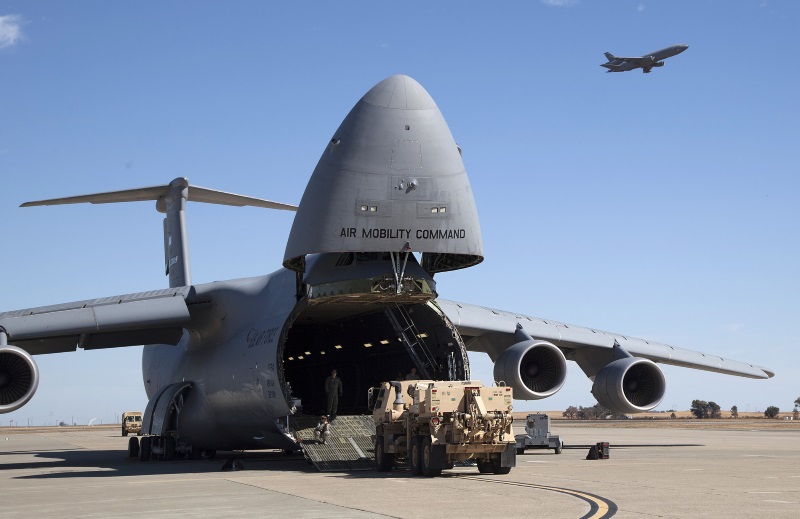
Having obtained a modernized avionics system, the C-5M gets software updates every now and then -- and less frequently a cockpit systems and mission processor update, primarily because parts go obsolete. More specifically, there has been a push to obtain a new color weather radar and a new lavatory, though the status of these efforts is unclear. Lockheed Martin has also investigated enhancements to increase the fuel efficiency of the C-5, an important consideration in an era of costly fuel. The most significant possible improvement would be 1.8-meter (6-foot) tall winglets. Fuel savings would be on the order of 3% -- which, given how much fuel a C-5 guzzles, would quickly pay off the upgrades. There is no commitment to winglets and such at present.
In addition, the USAF is considering kitting up the C-5M for the medevac mission. There was never anything to prevent that from happening, but the medevac mission was fulfilled by smaller cargolifters. The C-5M would be able to handle over a hundred litters.
BACK_TO_TOP* During the late 1960s and early 1970s, I used to see C-141s coming into Fairchild Air Force base near Spokane, Washington, on an occasional basis. Some claim it is an ugly aircraft, but I've always found it somewhat elegant myself. As far as the C-5 goes, I have a memory of one flying over Spokane in the same timeframe, with the thing so huge that it appeared to float in the sky like an airship.
In 1973, when I was stationed at Fort Hood, Texas, I also watched C-5s swallowing up an M-60 tank as part of the NICKEL GRASS airlift to Israel during the Yom Kippur War. It is an interesting memory to have observed history in progress, though the details have largely faded away. As I learned much later, the load I observed was unusual; tanks were only carried as something of a test, since the Israelis really needed spares and particularly ammunition.
* Sources include:
Some details on the C-5 were also obtained from a web document by Jason Hodgkiss, as well as THE AVIATION ZONE website, refreshingly dedicated to "big lifters" instead of the usual assortment of fighters and bombers more commonly favored on the web.
* Illustrations details:
* Revision history:
v1.0 / 01 jul 01 v1.0.1 / 01 jun 02 / Review & polish. v1.0.2 / 01 jun 04 / Review & polish. v1.0.3 / 01 jul 04 / Review & polish. v1.0.4 / 01 aug 06 / C-5M modernization program details. v1.0.5 / 01 jan 07 / Review & polish. v1.0.6 / 01 jan 09 / Review & polish. v1.0.7 / 01 apr 10 / Minor corrections on RERP. v1.0.8 / 01 may 12 / Review & polish. v1.0.9 / 01 apr 14 / Review & polish. v1.1.0 / 01 mar 16 / Review & polish. v1.1.1 / 01 feb 18 / Review & polish. v1.2.0 / 01 sep 21 / Review, update, & polish. v1.2.1 / 01 aug 23 / Review & polish. v1.2.2 / 01 aug 23 / Review & polish. (!)BACK_TO_TOP
